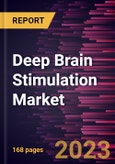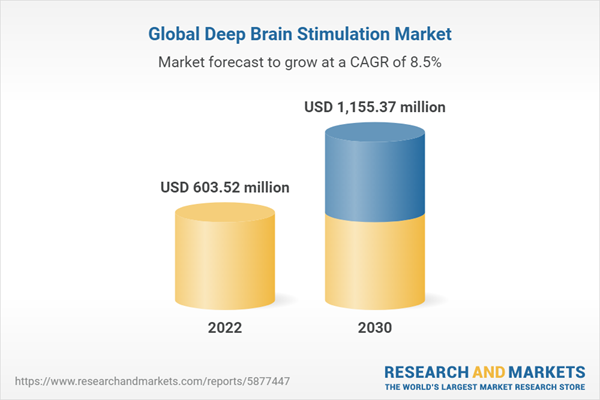Deep brain stimulation (DBS) refers to a device used for the purpose of providing electrical incitement to some areas of the brain to control the movement. They are extensively utilized to treat diseases such as Parkinson's disease, chronic pain, central pain syndrome, epilepsy, and obsessive-compulsive disorder among others. DBS helps in reducing the symptoms of stiffness, slowness, and walking problems caused by various neurological diseases. The deep brain stimulation market growth is attributed to the rising prevalence of neurological disorders and increasing demand for minimally invasive surgery.
Robotic implantation, multi-target stimulation, improved microelectrode designs, rechargeable pulse generators, and personalized, targeted programming are among the technological advancements in DBS. Owing to these advancements, DBS devices show fewer side effects and improved efficacy and symptom relief in Parkinson's patients compared to traditional methods. Abbott's Infinity Deep Brain Stimulation System is a technologically advanced new DBS that helps the patients manage their symptoms. It is the first wireless iOS software DBS mobile platform that has offered efficient and personalized therapy management with reduced risk of side effects.
In addition, there is an increase in FDA approvals for DBS devices in clinical applications such as tremors, severe obsessive-compulsive disorder, and dystonia. For instance, in March 2020, NeuroPace, Inc. received approval from the US FDA for MRI labeling its RNA system.
According to the MGM Healthcare press release published in February 2020, MGM Healthcare, Tamil Nadu, performed its first DBS for obsessive-compulsive disorder (OCD). Therefore, technological advancements in DBS are expected to create opportunities for the global deep brain stimulation market during the forecast period.
Further, advances in atlases, imaging techniques, and connectomics improve DBS targeting strategies. Improvements in lead design can make it possible to use segmented contacts for directional stimulation, and improvements in implantable pulse generator (IPG) design can result in small, longer-lasting magnetic resonance imaging (MRI) compatible batteries. Software advances can enable various programming strategies to improve efficacy while minimizing stimulation-related side effects and maximizing battery life. Brain recognition will help clinicians and researchers understand the physiological aspects of DBS and potentially act as another programming strategy. Closed-loop DBS can help tailor stimulation parameters to individual symptoms. In addition, remote and virtual programming could become more viable and accessible. DBS technology is widely used to treat various diseases and symptoms, and research is ongoing to improve current designs. In March 2023, researchers at Michigan Technological University used neuromorphic computing to improve the efficacy and energy efficiency of deep brain stimulation systems used to treat Parkinson's disease. Therefore, rising research and development activities in the field of deep brain stimulation are expected to bolster the deep brain stimulation market growth in the future.
End User -Based Insights
Based on end user, the deep brain stimulation market is categorized into hospitals, neurology clinics, ambulatory surgical centers, and others. In 2022, the hospitals segment accounted for the largest market share, and is anticipated to register the highest CAGR during the forecast period. The hospitals segment is expected to grow significantly owing to the rising prevalence of various neurological conditions such as Parkinson's and Alzheimer's disease and other disorders that can be treated effectively under skilled professionals in hospital settings. There is an increase in the number of DBS surgeries performed in hospitals. As per a study titled “Single-Stage Deep Brain Stimulator Placement for Movement Disorders,” published in 2021, approximately 160,000 patients worldwide have undergone DBS for various neurological and non-neurological conditions, and ~12,000 new patients receive DBS annually.Moreover, DBS surgeries require extreme precision and efficient medical attention; the availability of better treatment facilities at the hospitals and advanced DBS devices is a significant reason that is pushing patients to seek neurological treatments in hospital settings. In addition, hospitals also employ the highest quality of professional staff, including skilled and experienced neurologists, nurses, and technicians, that work together to provide patients with the best surgical care in a pleasant environment. Therefore, all the above-mentioned factors are expected to promote the deep brain stimulation market growth in the coming years.
The World Health Organization (WHO), National Institutes of Health (NIH), and Neurological Health Charities Canada (NHCC) are among the primary and secondary sources referred to while preparing the deep brain stimulation market report.
Table of Contents
Companies Mentioned
- Abbott Laboratories
- Aleva Neurotherapeutics SA
- Medtronic Plc
- Beijing PINS Medical Co Ltd
- Boston Scientific Corp
- Newronika SpA
- SceneRay Co Ltd
Table Information
| Report Attribute | Details |
|---|---|
| No. of Pages | 168 |
| Published | August 2023 |
| Forecast Period | 2022 - 2030 |
| Estimated Market Value ( USD | $ 603.52 million |
| Forecasted Market Value ( USD | $ 1155.37 million |
| Compound Annual Growth Rate | 8.5% |
| Regions Covered | Global |
| No. of Companies Mentioned | 7 |









